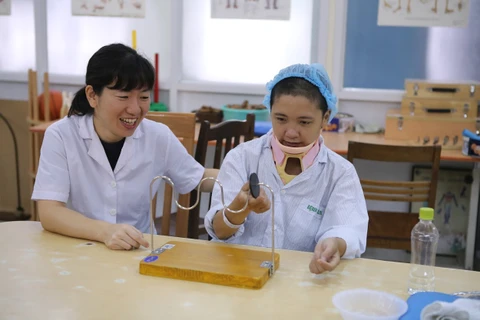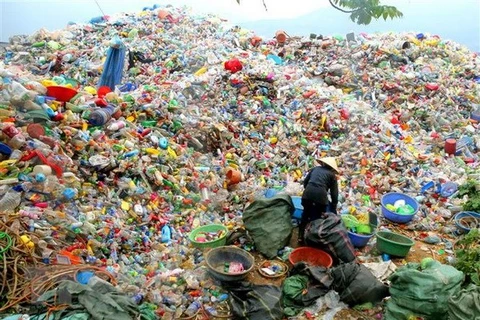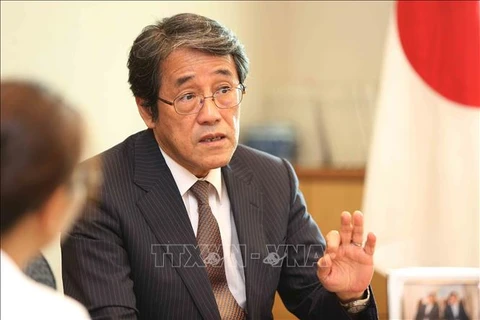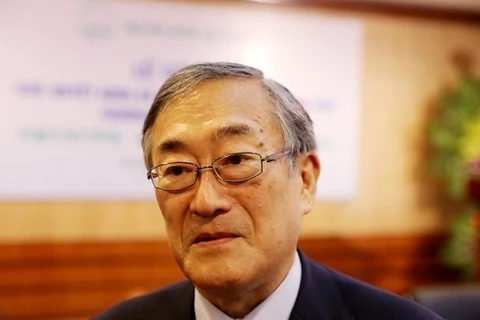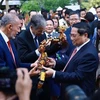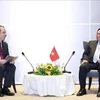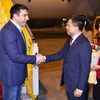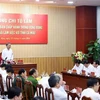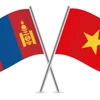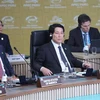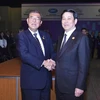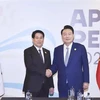 Nhat Tan Bridge, funded through Japanese official development assistance, in Hanoi is deemed a symbol of the Vietnam-Japan friendship (Photo: VNA)
Nhat Tan Bridge, funded through Japanese official development assistance, in Hanoi is deemed a symbol of the Vietnam-Japan friendship (Photo: VNA)Hanoi (VNA) – Vietnam and Japan are this year celebrating 45 years of their diplomatic ties, but bilateral relations date back to the 8th century. The over-1,000-year connections are now in their prime, with two countries in an Extensive Strategic Partnership for Peace and Prosperity in Asia.
In the 8th century, a monk named “Phat Triet” (Buttetsu) who came from Champa, an ancient kingdom that extended across the coast of what is today central Vietnam, introduced Rinyu-gaku – a composite ritual art comprising orchestral music and dance – to Japan. This event is considered the beginning of the two countries’ relations.
The prime of political relations
Weathering ups and downs in history, Vietnam and Japan established diplomatic ties on September 21, 1973, heralding a new era in their relations.
Since then, bilateral friendship has been strengthened by generations of leaders and people, becoming a precious asset of both sides.
Since the first visit to Japan by a Vietnamese Prime Minister – Vo Van Kiet – in 1993 and the first trip to the Southeast Asian nation by a Japanese Prime Minister – Tomiichi Murayama – the following year, the two countries have gradually enhanced bilateral links.
In October 2006, Vietnam and Japan issued a joint statement towards the Strategic Partnership for Peace and Prosperity in Asia. Nearly three years later, in April 2009, the Joint Statement on the Strategic Partnership for Peace and Prosperity in Asia was released.
This partnership was elevated to a new level in March 2014 when they set up the Extensive Strategic Partnership for Peace and Prosperity in Asia, helping make strong strides in their ties over recent years.
 Japanese Emperor Akihito and Empress Michiko wave at Hanoians when they visit the Temple of Literature on March 2, 2017, during a State visit to Vietnam (Photo: VNA)
Japanese Emperor Akihito and Empress Michiko wave at Hanoians when they visit the Temple of Literature on March 2, 2017, during a State visit to Vietnam (Photo: VNA) Notably, there were five mutual high-ranking visits in 2017 alone, including a State visit by Japanese Emperor Akihito and Empress Michiko in March, an official visit in January and a working trip in November by Japanese Prime Minister Shinzo Abe and an official tour by Speaker of the Japanese House of Representatives Tadamori Oshima in May. Vietnamese Prime Minister Nguyen Xuan Phuc paid an official visit to the Northeast Asian nation in June last year.
Most recently, President Tran Dai Quang made a State visit to Japan in May 2018, creating further momentum for the countries’ relations.
In a recent interview with Vietnam News Agency, Shigeki Takizaki, Director General of the Japanese Foreign Ministry’s Southeast and Southwest Asian Affairs Department, said bilateral connections have developed sustainably over the past 45 years, with the scope of cooperation expanded.
The trip to Vietnam by the Japanese Emperor and Empress in 2017 and a reciprocal visit by Vietnamese President Tran Dai Quang this year proved the countries’ relations have reached their highest-ever level, he noted.
In parliamentary ties, mutual visits and meetings between committees have increased. The Vietnam – Japan Friendship Parliamentary Group and the Japan – Vietnam Friendship Parliamentary Alliance have maintained contact and effective cooperation.
Bilateral dialogue mechanisms have also been sustained, including the Vietnam – Japan Cooperation Committee chaired by foreign ministers, the Strategic Partnership Dialogue on diplomacy, security and defence between deputy foreign ministers and the Defence Policy Dialogue and the Security Dialogue at the deputy ministerial level.
Japanese Ambassador to Vietnam Umeda Kunio said the two countries’ relationship is now in its best period, adding that amidst a changing world, it is increasingly important to reinforce bilateral cooperation.
He said: “In recent years, high-ranking delegation exchanges between the two countries have been held more and more regularly, the trust between their leaders has been increasingly profound, showing that Japan has special respect for relations and cooperation with Vietnam.”
Leading economic partners
Vietnam and Japan also boast long-standing economic ties which date back to the late 16th century, when Hoi An trading port, located in today’s central Quang Nam province, welcomed merchant vessels from Japan and became a trading centre of Japan with countries in Southeast Asia.
Nowadays, Japan is Vietnam’s second biggest foreign investor and ranks fourth among its trade partners.
According to Ambassador Umeda Kunio, economic partnerships have been growing strongly. More and more Japanese businesses have paid attention to Vietnam in recent years, as seen in the rising numbers of investment projects and Japanese firms in the country. In particular, projects aiming to serve the Vietnamese market, instead of for export purposes, have increased.
He noted that Japanese firms investing in Vietnam have numbered more than 3,100, up 40 percent in the last four years.
In terms of trade, they have given each other the most-favoured-nation treatment since 1999 and signed the Vietnam – Japan Economic Partnership Agreement in December 2008, creating a favourable legal framework for closer trade links.
Last year, bilateral trade reached 33.84 billion USD, up 13.8 percent year on year. That included nearly 17 billion USD worth of Vietnamese exports, up 14.9 percent, reported the General Department of Vietnam Customs.
Meanwhile, the countries inked the Investment Liberalisation, Promotion and Protection Agreement in November 2003.
 An automobile and motorbike spare parts factory of the Japanese-invested Nissin Manufacturing Vietnam Co. Ltd in Luong Son Industrial Park, Hoa Binh province (Photo: VNA)
An automobile and motorbike spare parts factory of the Japanese-invested Nissin Manufacturing Vietnam Co. Ltd in Luong Son Industrial Park, Hoa Binh province (Photo: VNA) Japan’s direct investment in Vietnam hit a record 9.1 billion USD in 2017, equivalent to 25 percent of total foreign direct investment here. As of August 2018, Japan had 3,865 valid projects worth more than 55 billion USD, ranking second among 129 countries and territories investing in the ASEAN nation.
Regarding official development assistance (ODA), Japan is currently the biggest provider for Vietnam, with its ODA accounting for some 30 percent of the total figure pledged to the country.
Many projects built with Japanese support have been put into use and contributed to local development, such as Terminal 2 of Noi Bai International Airport, Nhat Tan Bridge, Can Tho Bridge, Hai Van Tunnel, Hai Phong Port, Bach Mai and Cho Ray hospitals, and urban railway lines in Hanoi and Ho Chi Minh City.
Receiving President of the Japan International Cooperation Agency (JICA) Shinichi Kitaoka in Hanoi on September 14, Prime Minister Nguyen Xuan Phuc said Japanese ODA has contributed to socio-economic development in Vietnam, especially infrastructure expansion.
Shinichi Kitaoka said Vietnam’s economy and society have developed very well over the last three decades, and he is happy that development is partly attributable to Japanese ODA.
The Northeast Asian country is also assisting Vietnam to develop industry in the latter’s industrialisation strategy within the framework of bilateral cooperation.
Flourishing cooperation in all spheres
Aside from strengthened political and economic ties, the two countries’ connections in culture, education – training, labour and people-to-people exchange have also developed.
According to the Vietnam – Japan Friendship Association, more than 260,000 Vietnamese are working, studying and living in Japan, up by almost four-fold in the last five years and making Vietnamese the fifth largest foreign community in Japan. Meanwhile, there are nearly 20,000 Japanese in the Southeast Asian nation.
 A large number of people visit the Japanese Cherry Blossom Festival at the King Ly Thai To flower garden in Hanoi in March 2018 (Photo: VNA)
A large number of people visit the Japanese Cherry Blossom Festival at the King Ly Thai To flower garden in Hanoi in March 2018 (Photo: VNA) Japan has become the third biggest source of foreign tourists to Vietnam with nearly 800,000 visitors last year. The Vietnam Festival in Japan as well as the Japan Festival and the Cherry Blossom Festival of Japan in Vietnam have been held annually and have become much-anticipated events.
In education – training, Japan is one of the biggest non-refundable aid suppliers for Vietnam. The two sides have signed many cooperation agreements in this field. Notably, the Vietnam Japan University, based in Hanoi, is seen as a “lighthouse” project in bilateral relations.
Japanese Ministry of Justice data shows that by the end of October 2017, there were more than 240,000 Vietnamese working in Japan, 18.8 percent of the foreign workers there. Vietnamese form the second biggest community of foreign workers in Japan, following Chinese.
Stronger locality-to-locality links can also be seen in recent years. Thirty-seven pairs of localities have inked cooperation agreements, helping facilitate bilateral connections, especially in trade, investment and technology transfer.
Cooperation in other areas like agriculture, high technology, environment and climate change response has also expanded.
Katsuhito Asano, former Senior Vice Minister of Foreign Affairs of Japan, told Vietnam News Agency that after 45 years, Vietnam – Japan relations have been bolstered through not only stable political ties and expanding trade but also people-to-people exchange and cooperation in education, culture and sports.
Deputy Prime Minister and Foreign Minister Pham Binh Minh called the cooperation with Japan one of the most successful external relations of Vietnam, adding the 45-year path of bilateral relations will continue to bear fruit thanks to the increasingly strong cohesion between the two nations. –VNA
VNA
